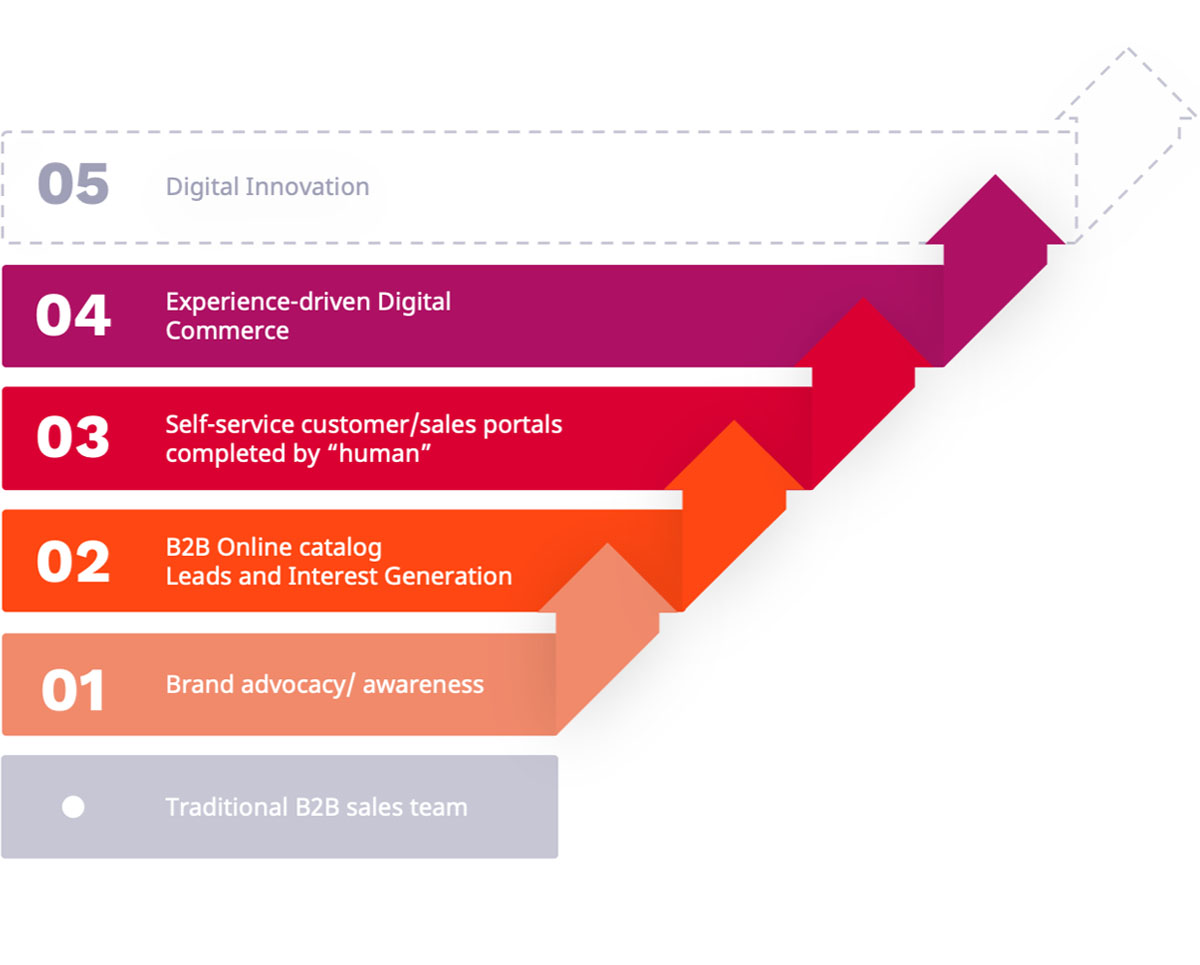The Digital Imperative
Ibexa Methodology
The Five Steps Towards Digital Maturity
Ibexa B2B Digital Transformation Methodology
More than a software publisher, Ibexa is also a complete methodology for supporting change for B2B companies wishing to engage in the digital transformation of their sales and marketing processes.
Indeed, it has never been so hard to initiate such a change as the B2B market is evolving rapidly, driven by ever-increasing expectations from new buyers. The latter have never been so volatile. According to McKinsey, 80% of B2B buyers - your customers - would change suppliers to get a better quality digital experience.

However, it is not a question of copying what has been done in recent years in the B2C universe. Typically B2C is aimed at individuals, whereas B2B is aimed at companies where an average of 11 people – sometimes 20 – are involved in the purchasing process (source McKinsey 2021). Where B2C markets simple products (or products requiring a simple purchase process), B2B mainly markets complex products that cannot be purchased in one simple click.
Faced with these challenges, most B2B companies are lost when it comes to accelerating their digital transformation. The question that comes up most often is “Where do I start? ".
It is precisely to help B2B companies that Ibexa, with thousands of projects carried out with its network of partners, has developed this methodology "Ibexa B2B DTM - Digital Transformation Methodology". This methodology is not a project but a journey that we have broken down into five phases. It is a solid basis to secure and accelerate your digital transformation.
On this page, you have access to a summary of our step-by-step methodology. If you would like access to the complete methodology or seek advice from our consultants, do not hesitate to contact us.

Step 1: Digital Brand Unification
When a B2B company wants to embark on its digital transformation, promoting its brand is the essential first step. For many, this seems obvious; for others it’s too big a leap to go straight to selling online and see immediate returns. This is once again, is misinterpreted by B2B companies. Their main concern is not to achieve short-term growth but to maintain market share.
Why is it important to have a strong brand online? Because the classic behavior of most new buyers is to research the brand online. At this point, don't be to concerned about not offering online catalogs, "sales rooms" or other features. Initial research by a buyer aims to perceive the seriousness of the brand, its robustness, its qualities.
This is where a DXP (Digital Experience Platform) can help you by making your brand consistent regardless of channels, languages or countries. A well-designed site will also enable you to be well placed in Google searches, protect your brand and catch the interest of potential buyers.
For more insights, download the eBook: Ibexa Methodology

Step 2: Digital Offerings
In B2B, and especially when marketing complex products, there is no point in going directly to online sales, even if it is tempting. Who would be prepared to buy a €10 million industrial printer online, in one click? No one. Absolutely no one.
That's why after strengthening your brand online (Step 1), the second step is to present your products online and develop opportunities through this new channel. Every B2B business is different but all buyers want detailed and up-to-date information about your products as well as their price and availability yet more than a third of buyers do not want to have any interaction with a seller or otherwise until the point of negotiation of the contract.
New buyers want to research and discover for themselves as much as possible about the products that interest them without human interaction; their research can be far-ranging, they want to get hold of as much information as possible, such as product characteristics and specifications.
This is why a DXP that incorporates a PIM (Product Information Manager) can help you immensely because it will allow you to promote your products and generate first qualified contacts. At this stage, we also recommend that you develop your Digital Marketing practices: landing pages for online advertising campaigns, SEO based on your product data, forms to capture your first leads, personalized content to better serve your customers.
A digital transformation project is above all a change management project, especially for your salesforces, who often have a dim view of digital, even though they know it is essential. These first steps with an online catalog will relieve them of repetitive daily tasks while strengthening their confidence by receiving first business opportunities via the digital channel.
For more insights, download the eBook: Ibexa Methodology

Step 3: Digital Selling
You are now ready to accelerate your digital transformation by offering real online sales functionalities. But still not the one-click shopping cart that your B2C specialist friend has been telling you about for the past six months!
So, what are B2B buyers expecting at this point? To be able to consult the products, view them, compare them, perform some cost/ volume/ profitability calculations etc. They want to go as far as possible on their own without interacting with your salespeople. Having an online account is therefore essential because they can save their searches, their baskets (often more than one, unlike in B2C)... For you - as a B2B company - it is an inexhaustible source of data that allows you to anticipate your sales, test new products, monitor the activity of your prospects online. This is also a great help for your salespeople.
But the use cases for Customer Portals don’t stop there. As new B2B buyers favor online purchases, customer portals can then turn into sales rooms to facilitate interaction between buyer and seller. The seller (your salesperson) can see buyers’ baskets and correct them live by being proactive ("These two products are not compatible, you would then have a quality problem, may I suggest to you..." ) all while talking by phone or better still, by videoconference fully integrated into the DXP B2B.
The potential of the sales room does not stop there: online contract signing, order history and tracking, quick new orders, etc. By developing these new features, you are doing your customers a favor and making them more loyal. Your salespeople are not left out because they become more efficient, allowing them to focus on the essentials: advising customers.
For more insights, download the eBook: Ibexa Methodology
Buyers are more willing than ever before to spend big through remote or online sales channels, with 35% willing to spend $500,000 or more in a single transaction (up from 27% in February 2021). 77% of B2B customers are also willing to spend $50,000 or more

Step 4: Digital commerce/ e-commerce
We're getting there, finally!
In B2B and even for those who sell complex products, there is a place for online sales. This is why it is important to rely on a DXP that also covers this use case.
Here too, B2B has distinct characteristics: access/ view by company, access/ delegation by employee, catalog by company, price by company, specific rules, validation workflow, etc. You have to know how to take these into account to adapt to the needs of B2B buyers.
The main use case of online sales in B2B lies in the sale of consumables or complementary products. Let's take the example of the industrial printer at €10 million, once purchased via the sales room, the customer can connect to your online store to buy spare parts, consumables (inks), support services... without needing to search for hours because your sales rep has already set up a restricted view of your catalog based on previous purchases. This becomes a win-win situation: the buyer saves time, so too does the salesperson by avoiding small repetitive tasks which still can bring a lot of value to the company.
Of course, online B2B sales are not limited to this use case, but we present to you here what is done best while maintaining a time to market adapted to the expectations of new B2B buyers.
For more insights, download the eBook: Ibexa Methodology

Step 5: Continuous innovation
Digital has no bounds which is a good thing!
Once the first four steps are implemented, the job is not yet done! But first, let's take stock - you have a coherent brand online, you reap many opportunities, your products are accessible online and well valued, you develop your sales thanks to the optimized Buyer/ Seller interaction, you improve your margins by sales of complementary products, … but above all, it is your entire B2B company that has been transformed, that has gained digital skills and which is now in control.
At Ibexa, we recommend this Step by Step methodology because it is the best way to avoid failures and prepare for the future. But we say that the transformation is not complete as we can now talk about CDP, CPQ, and much more…😉
For more insights, download the eBook: Ibexa Methodology